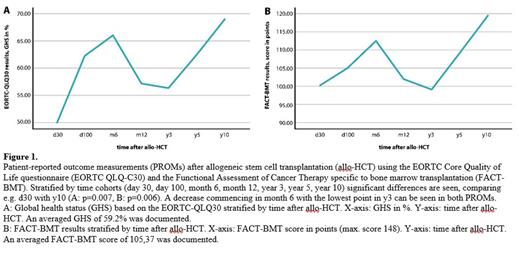Introduction
Increasing outpatient care in all medical departments will pose a challenge for daily routines and force us to rethink established processes. In hemato-oncology there is good evidence for the continuous improvement of overall survival after allogeneic stem cell transplantation (allo-HCT) during the last decades. However, the chronic character of the underlying hematopoietic malignancy and the accompanying long-lasting consequences of an allo-HCT are often not properly addressed in follow-up care. The health care status of this population should be determined on physical and mental condition and serious longer-term sequelae need to be monitored more closely than on quarterly basis. Patient-reported outcome measurements (PROMs) are able to address this issue in clinical routine and capture the multidimensional construct of quality of life (QoL). PROMs focus mainly on how a patient survives after a treatment, and not only on whether she/he survives and how long.
Patients and Methods
We performed a cross-sectional survey including all adult allo-HCT recipients who attended follow-up care in the period from March to July 2023 at the University Hospital Tübingen, Germany. Eligible participants completed both, the EORTC Core Quality of Life questionnaire (EORTC QLQ-C30) and the Functional Assessment of Cancer Therapy General (FACT-G) with the subscale for Bone Marrow Transplantation (FACT-BMT). We built 8 cohorts (day 30, day 100, month 6, month 12, year 3, year 5, year 10 and >10 years) to evaluate QoL after allo-HCT and to identify predictors like age, performance status (PS), conditioning regime, graft-versus-host disease (GvHD) development and relapse.
Results
We included 200 recipients (93 women, average age 54.2 years) who received allo-HCT between 2004 and 2022. The majority was treated for acute leukemia (n=95), followed by chronic leukemia (n=16), myelofibrosis (n=25), myelodysplastic neoplasm (n=20), lymphoma/myeloma (n=14) and others (n=30). 82.5% (n=165) received reduced-intensity conditioning (RIC) and 17.5% (n=35) myeloablative conditioning (MAC). 75.5% (n=151) of allogeneic donors were HLA-matched, 14.5% (n=29) HLA-mismatched and 8.5% (n=17) haplo-identical. The median follow-up was 43.4 months with the following patient numbers in the 8 cohorts: n=25 (d30), n=21 (d100), n=24 (m6), n=34 (m12), n=32 (y3), n=30 (y5), n=23 (y10) and n=11 (>10y). 73% (n=146) showed complete remission at last follow up, 14% (n=28) relapsed. Acute GvHD was observed in 39% (n=78) with additional 6.5% (n=13) suspected to have one. Chronic GvHD was observed in 39.5% (n=79).
Average GHS in the EORTC QLQ-30 was 59.2%, average total scores in the FACT-G and FACT-BMT were 77.68 (max. score 108) and 105.37 (max. score 148), respectively. Both PROMs (EORTC QLQ30, FACTs) demonstrated the same biphasic course with a significant QoL recovery over time (Figure 1), comparing for example the global health status (GHS) on d30 (50%) with y10 (68,8%, p=0.07). Interestingly, allo-HCT recipients again experience a drastic decrease achieving y3, mainly caused by worse emotional and physical well-being. The median ECOG PS before allo-HCT was 0 and degraded to 1 in all cohorts until y10, where a return to baseline was seen. Current PS and PRO results showed a significant correlation (p<0.001). No correlations between QoL and age, GvHD or conditioning regime were found.
Conclusion
Allo-HCT recipients manage to regain a good QoL in long-term follow-up over 10 years but experience a significant low around y3. PROMs are able to detect such developments and can help to improve patient management. As indicated by our data, a higher degree of support in y3 could improve QoL and well-being of allo-HCT patients. However, until today, we lack the implementation of efficient strategies to do so in clinical routine.
Disclosures
No relevant conflicts of interest to declare.


This feature is available to Subscribers Only
Sign In or Create an Account Close Modal